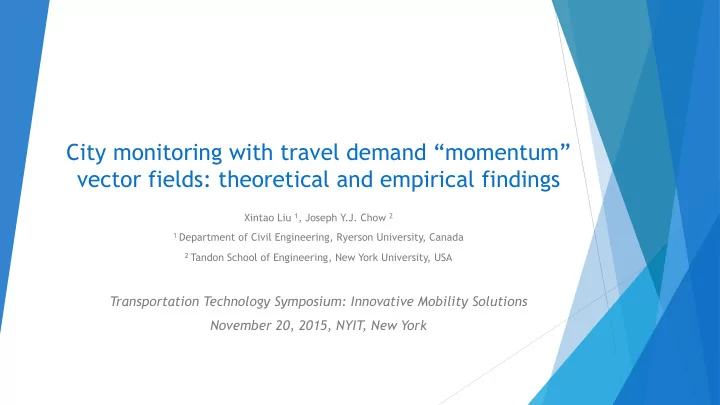

City monitoring with travel demand “momentum” vector fields: theoretical and empirical findings Xintao Liu 1 , Joseph Y .J. Chow 2 1 Department of Civil Engineering, Ryerson University, Canada 2 Tandon School of Engineering, New York University, USA Transportation Technology Symposium: Innovative Mobility Solutions November 20, 2015, NYIT, New York
Outline u Introduction u Methodology q Time-geographic 3D representation q Generation of vector field q Projecting travel demand u Study area and data u Travel survey data in Toronto, Canada u Real-time taxi data in Beijing, China u Results and discussion q Visual analytic analysis q Travel demand pattern analysis u Conclusion and future work 2
Introduction How to incorporate human mobility data into assessment of urban systems? u 3 New York taxi visualization (source: http://taxi.imagework.com )
Introduction (cont.) u Goal 1: Propose a population-based vector field for visualizing time- geographic travel demand; u Goal 2: Theoretical and empirical verification using travel data; u Goal 3: Develop an integrated 3D analytical GIS package. 4
Introduction (cont.) u Time geography by Hägerstrand (1970) 5 Source: https://en.wikipedia.org/wiki/Time_geography
Introduction (cont.) u Studies on travel behavior and demand patterns are limited to understanding individuals ’ activity patterns 6 Miller, H. J., Bridwell, S. A., 2009. A field-based theory for time geography. Annals of the Association of American Geographers , 99(1), 49-75. ¡
Introduction (cont.) u Studies on travel behavior and demand patterns lack directionality at a population level. Chen, J., Shaw, S.-L., Yu, H., Lu, F., Chai, Y., Jia, Q., 2011. Exploratory data analysis of activity 7 diary data: a space-time GIS approach. Journal of Transport Geography 19 (3), 394-404.
Methodology u Time-geographic 3D representation of urban space 8 Time-geographic 3D representation of urban space
Methodology (cont.) u Discretization of travel trajectory Travel vector splitting by time slot 9
Methodology (cont.) u Generation of vector field 10 How line based vector kernel density works ¡
Methodology (cont.) u Projecting travel demand onto Point of Interest (POI ) 𝑊𝐿𝐸 = ∑𝑗 =1 ↑𝑜▒(𝐵𝑗 1× 𝐶𝑗 1+ 𝐵𝑗 2× 𝐶𝑗 2 ) 𝑜 ¡is ¡the ¡number ¡of ¡cells ¡within ¡search ¡radius ¡ from ¡the ¡current ¡cell, ¡ [ 𝐵𝑗 1 ¡ 𝐵𝑗 2] ¡ is ¡the ¡ 𝑗↑𝑢ℎ ¡Cell-‑ POI ¡vector, ¡and ¡ [ 𝐶𝑗 1 ¡ 𝐶𝑗 2] ¡is ¡the ¡cell ¡vector 11 Projection of vector kernel density onto Point of Interest (POI) as traffic demand ¡
Methodology (cont.) u Open source GIS project: 3DKernel on GitHub 12
Study area and data: Toronto u Transportation Tomorrow Survey data, Toronto, Canada (a) 2,272 zones in Great Toronto Area in red points, and (b) 624,845 trips of 311,022 persons from 13 118,280 households in the year 2011.
Study area and data: Beijing u Taxi GPS data in Beijing, China Study area: built-up area within the 6 th ring road in Beijing, China (left) and total daily real-time 14 GPS locations from 12,000 taxis (right) on Nov. 2, 2012.
Results and discussion u This research filled previous research gap using vector kernel density 15 Liu, X., Yan, W. Y., & Chow, J. Y., 2014. Time-geographic relationships between vector fields of activity patterns and transport systems. Journal of Transport Geography , 42, 22-33. ¡
Results and discussion (cont.) u Difference of densities The difference of densities at 8:00 AM between the year 2006 and 2011 in GTA. (Note: the blue arrow means the negative differences, while the red arrow means thepositive differences). 16
Results and discussion (cont.) u Areas of density as the indicator of accessibility. The transit line and stops of bus #506 in Toronto (left) and its areas of density as the indicator of accessibility. 17
Results and discussion (cont.) u Visual analytic analysis 18 3D KD map during the day of Nov. 2, 2012 in Beijing.
Results and discussion (cont.) u Visualization of impulses 19 Vector kernel density differentials between 7:00 to 8:00 in four consecutive days in Nov. 2012, Beijing, China ¡
Results and discussion (cont.) u Travel demand pattern analysis Mixed dot product projection of travel demand onto POIs 0.8 0.7 KD Projection 0.6 0.5 0.4 0.3 0.2 0.1 0 0 4 8 12 16 20 24 4 8 12 16 20 24 4 8 12 16 20 24 4 8 12 16 20 24 Friday, Nov. 2, 2012 Saturday, Nov. 3, 2012 Sunday, Nov. 4, 2012 Monday, Nov.5, 2012 Time of Day CBD Forbbiden City South Rail Station Airport IT Center 20 Mixed scalar projection of travel demand onto five selected POIs in Beijing
Results and discussion (cont.) u Travel demand pattern analysis Dot product projection of travel demand towards/away from CBD 𝐸𝑓𝑛𝑏𝑜𝑒 = ∑𝑢 =0 ↑𝑜▒𝑋↓𝑢 𝑈↓𝑢 1.8 1.6 Dot Product Projection 1.4 1.2 1 0.8 0.6 0.4 𝑆𝑏𝑢𝑓 = ¡ 𝐸↓𝑢𝑢 − ¡ 𝐸↓𝑢𝑏 /𝐸↓𝑢𝑏 0.2 0 0 4 8 12 16 20 24 4 8 12 16 20 24 4 8 12 16 20 24 4 8 12 16 20 24 Friday, Nov. 2, 2012 Saturday, Nov. 3, 2012 Sunday, Nov. 4, 2012 Monday, Nov.5, 2012 Time of Day CBD In CBD Out 21 Comparison and calculation of travel demand projection towards/away from POIs.
Conclusion and future work u Conclusion q The results demonstrated the capability in visual analytics of travel demand using vector kernel densities from both theoretical and empirical perspectives; q An integrated 3D analytical GIS package is developed and shared as an open source project for further extension and validation for general purposes in related urban studies. 22
Conclusion and future work (cont.) u Future work q An online version with a real-time dashboard for travel impact visualization and quantification for public agencies, e.g. using taxi data from city of DOT in New York; q More urban information (e.g. land use) to be integrated to infer semantic meanings. 23
Thanks for your attention! Questions? joseph.chow@nyu.edu 1 1 Tandon School of Engineering, New York University, USA u xintao.liu@ryerson.ca 2 2 Department of Civil Engineering, Ryerson University, Canada u 24
Recommend
More recommend